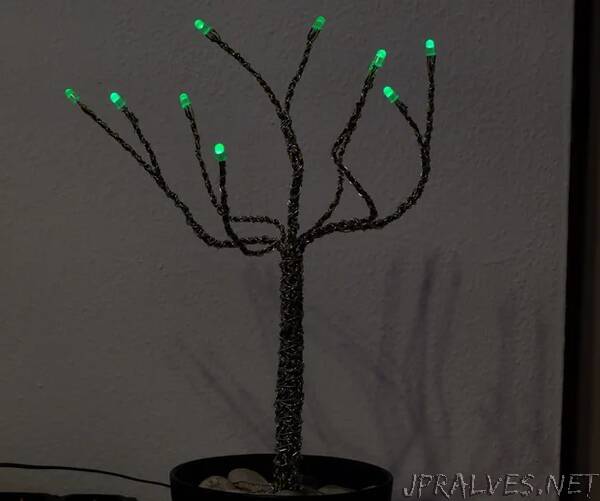
“I want to a share with you my RGB-LED wire tree. One evening I remembered building wire trees as a kid. Nowadays I really enjoy building small electronic projects with microcontrollers similar to arduino, especially with LEDs. So i thought to myself, why not combine both and the idea of an LED wire tree was born. First I checked, if someone had already done something like this before but I didn’t find what I was looking. I could mainly find LED wire trees that show one colour. As I think single colour LEDs are a bit boring, I wanted to have one with RGB-LEDs to be able to let the wire tree appear in all colours of the rainbow. So I startet to build one myself. The result you can see in the image above. The wire tree I based this instructible on is my third one. I hope you enjoy my instructable and I can motivate some of you to make one yourself.
Supplies:
For the project itself you only need a few supplies and tools:
10 RGB-LEDs (+ spares in case one is damaged), or more if you like
copper wire 0,14 mm² (or thicker, but not too thick as it will get difficult to braid) with 3 different coloured insulations around 5 m per colour (Number of LEDs x length between 40 and 50 cm)
silver wire 0,6 mm around 15 m (2 to 3 times the length that is need of each colour)
microcontroller, in my case a Wemos D1 mini, but basicly everyone will work as long as it fits in the flower pot)
Power source (in case of Wemos D1 mini any micro-usb phone charger will work)
3 MOSFETs or transistors (I used n-channel Mosfets but you can also use p-channel if you adapt the circuit)
Resistors of different values
Heat shrinking tubing or electrical tape
Flower pot
Hot glue
Stones
Small wooden sticks (for example the sticks from the new year rockets)
Thin wooden board (for example the bottom of the wooden boxes sometimes fruits are sold in)
Optional
Pin Headers (male and/or female)
Breadboard
Tools
Soldering iron
Wire cutter
Drill
Tweezers (optional)
Helping Hand (optional)
Rotation tool (optional)
Most of the things you need are shown in one of the Pictures above. You can get them in hardware stores, craft stores or Amazon. Some things however can come for free: The stones I took from a nearby field. And the wooden board was waste until I recycled the fruit box.”
